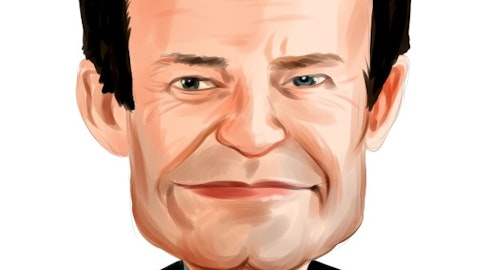Bill Katz: All right. Thanks for the clarification. Thank you.
Operator: We’ll take our next question from Steven Chubak with Wolfe Research.
Steven Chubak: Hi. Good morning, Ron and good morning Jim.
Ron Kruszewski: Good morning Steven.
Steven Chubak: So I wanted to start off just unpacking some of the assumptions underpinning the 2024 fee guidance. Didn’t catch if you guys, and so I’m sorry if I missed this if you alluded to the equity market appreciation that you’re assuming in the coming year? And specifically for FICC brokerage, is this $100 million Jim a reasonable jumping off point given the tailwinds from both steeping that you cited in the prepared remarks?
Jim Marischen: So specific to fixed income, I think the conversations we’re having with the people that run that business, as they continue to see increased levels of activities. Obviously, with the Fed’s change in stance, the unwinding of some of the unrealized losses on bank balance sheets. Going forward, you’ll probably see banks use and rely on each TM on a lesser basis. You’re starting to see that and so you’re starting to see more activity and we do anticipate that to continue. We do feel like at this point, we’re being a little bit conservative, but it’s a reasonable jumping off point to look at what happened in the fourth quarter and maybe discount off that a little bit. But we are seeing some very positive trends across the fixed income area.
Ron Kruszewski: And I would add that as I think we talked about in previous calls and we’ve made some meaningful hires in that space both in the SBA and in the Jenny space which deals with origination and provides product to many of our end buyers. And so that wasn’t — that’s just getting ramped up, and that’s a not less than material opportunity for us with the hires we’ve made there. So I think that just underscores that I think it is a reasonable jumping off place.
Steven Chubak: That’s great. And the equity market appreciation that you guys are assuming?
Ron Kruszewski: For asset management fees?
Jim Marischen: Yeah. I mean I think we just took some of our internal expectations, some of our internal account. I forget what the exact percentage increase in market appreciation is, but I can follow up on that.
Steven Chubak: Okay. Great. And just on the non-comp implied guidance. I know that you had the legal charge, there was a fair amount of noise this past year. But just looking at the core non-comp trends, ex legal those have been growing roughly at about a high single-digit CAGR since 2019. The 2024 non-comp guide actually implies a bit of contraction from what we can tell. So I just want to understand what’s driving the better expense control in the coming year at least relative to recent history?
Ron Kruszewski: Well, we’re talking about percentage of net revenue, okay? And so, first of all, there’s always some noise in our fourth quarter. As always, if you look, you’ll always see that is historically higher. I mean we just we have really pushed a cutoff on all of our expenses to make sure that they’re in. And if you go back over years, you’ll see that the fourth quarter tends to be above trend for the year. And there’s leverage in the model. So while I expect non-comp expense to increase, as we raise revenues that’s where the leverage in the model. That’s why we see our margins getting into the mid-20s because of that percentage will come down as revenues rebound.
Steven Chubak: Okay. So the expectation though is that the dollars will at least increase in non-comps, but the ratio will improve with some of the operating leverage?
Jim Marischen: Yeah. And if you look specifically at the fourth quarter, there’s some seasonality in there. When you think about the fourth quarter, you typically see elevated levels of travel entertainment as well as some statement-related expenses. We also had some third-party legal expenses that were somewhat elevated in the fourth quarter. Those are lumpy. Those are hard to predict. And you think about those in a normalized run rate when you’re comparing kind of the results in the fourth quarter, normalizing some of those things on an annual basis. In addition to the revenue increases that Ron talked about is really what’s getting you to the levels in our guidance range.
Steven Chubak: Really helpful color. Thanks so much for taking my questions.
Operator: We’ll take our next question from Chris Allen with Citi.
Chris Allen : Yes, good morning, guys. Maybe you can just dig in a little bit on the investment banking pipeline. Just wondering if you’re seeing the improvement across all verticals or specific verticals? Maybe give us some color just whether you’re starting to see any signals that bank activity specifically is picking up? I mean, obviously, you start to see some activity on the fixed income trading side. I wonder if that’s filtering through at all on the banking side?
Ron Kruszewski : Well, for sure. I mean, the engagement in the tone and frankly, some deals getting done is definitely improving. I’m cautious Chris just because we’ve been talking about improvements in green shoots and all of that for quite a while here. So the — I just see the tone being much better. We asked about where is certainly health care, industrials, FIG and Tech. So it’s kind of broad-based when we look at our pipeline. I just want to make a more generalized comment here, which is we’ve been through pretty much a recession in this business with equity capital raising down like 70% over almost whatever time frame you want to compare it to as it relates to 2021 and M&A down 50%. And that environment is not going to continue.



